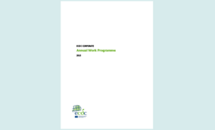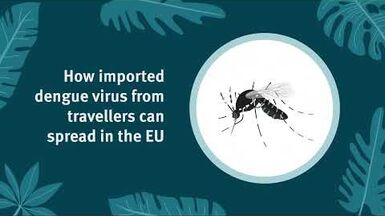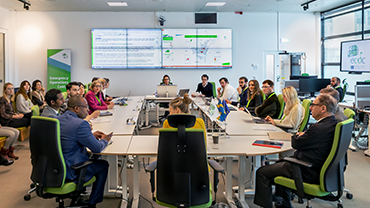ECDC Annual Work Programme 2014
As stated in Article 14.5(d) of ECDC’s Founding Regulation, [The Management Board shall:] “adopt, before 31 January each year, the Centre’s programme of work for the coming year.” The ECDC Annual Work Programme 2014 is based on ECDC’s Strategic Multi-annual Programme (SMAP) 2014-2020. The activities to be implemented in 2014 are clearly and individually linked to the long-term strategies of ECDC. In 2014, ECDC will further reinforce the: collaboration and cooperation with EU institutions, Member States and international partners; consolidate its core and support functions; strengthen the role and outputs of the seven disease programmes; and ensure that leadership, administration and ICT efficiently support the core operations of the Centre.
Executive Summary
This new ECDC annual work programme is uniquely important in that it marks two important transitions for ECDC. The first of these is the transition between our strategic multi-annual programme (SMP) for 2007-2013, which covered our start-up period, to our SMAP 2014-2020, a period which we enter as a “cruising speed” EU Agency. The second transition is from the era when Decision 2119/98/EC of the European Parliament and Council provided the legal basis for cooperation and coordination between Member States and the Commission in the fight against infectious diseases, to the new era of the Serious Cross Border Health Threats Decision. On 6 November 2013 Decision 1082/2013/EU of the European Parliament and of the Council entered into force, repealing Decision 2119/98/EC. The new Decision brings with it a significantly stronger framework for EU cooperation against infectious diseases. While the new Decision does not change ECDC’s mandate, we will certainly have a role to play in giving technical support to Member States and the Commission as they implement this important new piece of legislation.
ECDC’s SMAP 2014-2020 brings some changes in the way we structure this year’s programme: for example, there are specific strategies on “Microbiology support” and “Ensuring independence”. However, when you read our programme for 2014, I think that what will strike you most is the high level of continuity with previous years.
The starting points for developing SMAP 2014-2020 were ECDC’s Founding Regulation (which has not changed since 2004) and feedback from our partners in the Member States and EU Institutions on their priorities for ECDC over the coming years. Our partners had many valuable ideas on how ECDC could be further improved, but they also told us that they valued our core public health functions and our disease specific programmes. Building up these functions and establishing the programmes were the core objectives of ECDC’s first SMAP. This feedback was therefore a double tribute to ECDC: we defined the right course of action in our first SMAP, and then we delivered on our promises. The fundamentals of what ECDC does, therefore, stay largely the same in the new programme.
There are some changes in the terminology we use, and how our various strategies are structured and numbered. But the way in which we group the different diseases ECDC covers has not changed, and there is a high degree of continuity in our core activities, such as surveillance, risk assessment, scientific advice and public health training. In each area of our work, there is some evolution in the specific priorities we pursue, and we aim to further improve the European added value of our work. And, reflecting the priority given to performance management in SMAP 2014-2020, there is a section on this topic in our work programme for 2014.
In summary then, our approach is to continue delivering on ECDC’s mandate, but doing it even better and supporting the Commission as it implements Decision 1082/2013/EU.
Download

Read more on the ECDC website
ECDC corporate
ECDC strategic multi-annual programme 2014–2020
This document sets out the overall programme priorities for 2014–2020, setting them in the context in which ECDC operates and the changes and challenges that will affect communicable diseases in the EU Member States and EEA countries over that period.







